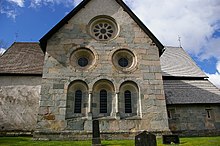Nydala Monastery
| Cistercian Abbey of Nydala | |
|---|---|
 The monastery after it was sacked by Christian II. Engraving by Erik Dahlberg |
|
| location |
Jönköpings län |
| Coordinates: | 57 ° 19 '22.8 " N , 14 ° 20' 28.6" E |
| Serial number according to Janauschek |
182 |
| founding year | 1143 |
| Year of dissolution / annulment |
1527 |
| Mother monastery | Clairvaux Monastery |
| Primary Abbey | Clairvaux Monastery |
|
Daughter monasteries |
Gudvala Monastery / Roma (1164) |
The Nydala Abbey was a monastery for monks of the Cistercian order . It was on the northern edge of Lake Rusken in what is now the Swedish municipality of Värnamo in Småland .
Nydala was founded in 1143 together with the Alvastra monastery ; it was the first two monasteries in what was then Sweden. The name Nydala ( Latin nova vallis 'new valley') refers to the mother monastery of the order in Clairvaux, France (Latin clara vallis 'clear / bright valley'). In accordance with the rules of the order, the buildings were erected far away from other settlements on vacant land. There is evidence that the monks built a brick factory to build the monastery. In 1164 monks from Nydala founded the Roma monastery on Gotland . Nydala is the only Swedish Cistercian monastery that still has a chapel from the time it was built.
Management
Initially, the monks supplied themselves by fishing in Lake Bolmen and in the Bolmån River. The fishing rights were granted to them several times by the kings of the families Erik and Sverker . Later, the monastery also included agricultural land and forests. Heinrich von Uppsala encouraged the inhabitants of the region to help expand the monastery in 1258. As an incentive, he promised the helpers that part of the indulgence payment would be waived . In the following years the monastery received part of the tithe that the bishops of Linköping demanded from the farmers in the area.
The Popes Boniface IX. and Julius II prepared letters of protection in 1390 and 1503, respectively, confirming the monastery's privileges. At the beginning of the 16th century, Nydala was the largest Cistercian monastery in Sweden, with around 250 farms. This made it the largest landowner in Småland . In this respect, it was only surpassed in Sweden by the Vadstena monastery , to which about 1000 farms were attached.
Decline
Christian II stopped in Nydala in 1521 on his way home from the Stockholm bloodbath . The next day he had the monastery ransacked. According to a legend, he ordered that a hole should be made in the ice of the adjacent lake Rusken, in which the abbot and several monks were drowned.
The monastery was reopened in 1524, but in 1529 King Gustav Wasa had the property confiscated for the crown. In the course of the Three Crown War , Danish troops burned down the monastery buildings. Today only the ruins of the farmer's church, remains of smaller medieval houses and the parts of the monastery church that were integrated into the new church of the parish exist.
